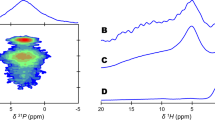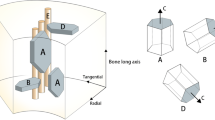Summary
The properties of bone mineral change with age and maturation. Several investigators have suggested the presence of an initial or “precursor” calcium phosphate phase to help explain these differences. We have used solid state 31P magic angle sample spinning (MASS) nuclear magnetic resonance (NMR) and X-ray radial distribution function (RDF) analyses to characterize 11-and 17-day-old embryonic chick bone and fractions obtained from them by density fractionation. Density fractionation provides samples of bone containing Ca-P solid-phase deposits even younger and more homogeneous with respect to the age of mineral than the calcium phosphate (Ca-P) deposits in the whole bone samples. The analytical techniques yield no evidence for any distinct phase other than the poorly crystal-line hydroxyapatite phase characteristic of mature bone mineral. In particular, there is no detectable crystalline brushite [DCPD, CaHPO4 2H2O< 1%] or amorphous calcium phosphate (< 8–10%) in the most recently formed bone mineral. A sizeable portion of the phosphate groups exist as HPO4 2− in a brushite (DCPD)-like configuration. These acid phosphate moieties are apparently incorporated into the apatitic lattice. The most likely site for the brushite-like configuration is probably on the surface of the crystals.
Similar content being viewed by others
References
Posner AS (1969) Crytal chemistry of bone mineral. Physiol Rev 49:760–791
Termine JD (1972) Mineral chemistry and skeletal biology. Clin Orthop 85:207–241
Glimcher MJ, Bonar LC, Grynpas MD, Landis WJ, Roufosse AH (1981) Recent studies of bone mineral: Is the amorphous calcium phosphate theory valid? J Cryst Growth 53:100–119
Termine JD, Posner AS (1967) Amorphous/crystalline interrelationships in bone mineral. Calcif Tissue Res 1:8–23
Neuman WF, Bareham BJ (1975) Evidence for the presence of secondary calcium phosphate in bone and its stabilization by acid production. Calcif Tissue Res 18:161–172
Brown WE (1966) Crystal growth of bone mineral. Clin Orthop Rel Res 44:205–220
Aue WP, Roufosse AH, Roberts JE, Glimcher MJ, Griffin RG (1984) Solid state 31P nuclear magnetic resonance studies of synthetic solid phases of calcium phosphate. Biochemistry 23:6110–6114
Roufosse AH, Aue WP, Glimcher MJ, Griffin RG (1984) An investigation of the mineral phases of bone by solid state 31P magic angle sample spinning nuclear magnetic resonance. Biochemistry 23:6115–6120
Bonar LC, Grynpas MD, Roberts JE, Griffin RG, Glimcher MJ (1985) Physical and chemical characterization of the development and maturation of bone mineral. In: Butler William T (ed) The chemistry and biology of mineralized tissue. Ebsco Media, Birmingham, AL, pp 226–233
Roufosse AH, Landis WJ, Sabine WK, Glimcher MJ (1979) Identification of brushite in newly deposited bone mineral from embryonic chicks. J Ultrastr Res 68:235–255
Bonar LC, Roufosse AH, Sabine WK, Grynpas MD, Glimcher MJ (1983) X-ray diffraction studies of the crystallinity of bone mineral in newly synthesized and density fractionated bone. Calcif Tissue Int 35:202–209
Dryer RL, Tammes AR, Routh JI (1957) The determination of phosphorus with N-phenyl-p-phenylenediamine. J Biol Chem 225:177–183
Pellegrino ED, Biltz RM (1972) Mineralization in the chick embryo. I. Monohydrogen phosphate and carbonate relationships during maturation of the bone crystal complex. Calcif Tissue Res 10:128–135
Wagner CNJ (1978) Direct methods for the determination of atomic-scale structure of amorphous solids. J Non-crystalline Solids 31:1–40
Grynpas MD, Bonar LC, Glimcher MJ (1984) X-ray diffraction radial distribution function studies of bone mineral and synthetic calcium phosphates. J Mater Sci 19:723–736
Grynpas MD, Bonar LC, Glimcher MJ (1984) Failure to detect amorphous calcium phosphate solid phase in bone mineral: a radial distribution function study. Calcif Tissue Int 36:291–309
Pines A, Gibby MJ, Waugh JS (1973) Proton-enhanced NMR of dilute spins in solids. J Chem Phys 59:569
Opella SJ, Frey MH (1979) Selection of nonprotonated carbon resonances in solid-state nuclear magnetic resonance. J Am Chem Soc 101:5854
Munowitz M, Griffin RG, Bodenhausen GJ, Huang TH (1981) Two-dimensional rotational spin-echo nuclear magnetic resonance in solids: correlation of chemical shift and dipolar interactions. J Am Chem Soc 103:2529
Bonar LC, Grynpas MD, Glimcher MJ (1984) Failure to detect crystalline brushite in embryonic chick and bovine bone by x-ray diffraction. J Ultrastr Res 86:93–99
Posner AS, Perloff A (1957) Apatites deficient in divalent cations. J Res Nat Bureau of Standards 58:279–286
Rothwell WP, Waugh JS, Yesinowski JP (1980) High-resolution variable-temperature 31P-NMR of solid calcium phosphates. J Am Chem Soc 102:2637–2643
Tanzer ML, Hunt RD (1964) Experimental lathrysm, and autoradiographic study. J Cell Biol 22:623–631
Biltz RM, Pellegrino ED (1972) The hydroxyl content of calcified tissue mineral. Calcif Tissue Res 7:259–263
Author information
Authors and Affiliations
Rights and permissions
About this article
Cite this article
Roberts, J.E., Bonar, L.C., Griffin, R.G. et al. Characterization of very young mineral phases of bone by solid state 31Phosphorus magic angle sample spinning nuclear magnetic resonance and X-ray diffraction. Calcif Tissue Int 50, 42–48 (1992). https://doi.org/10.1007/BF00297296
Received:
Revised:
Issue Date:
DOI: https://doi.org/10.1007/BF00297296




